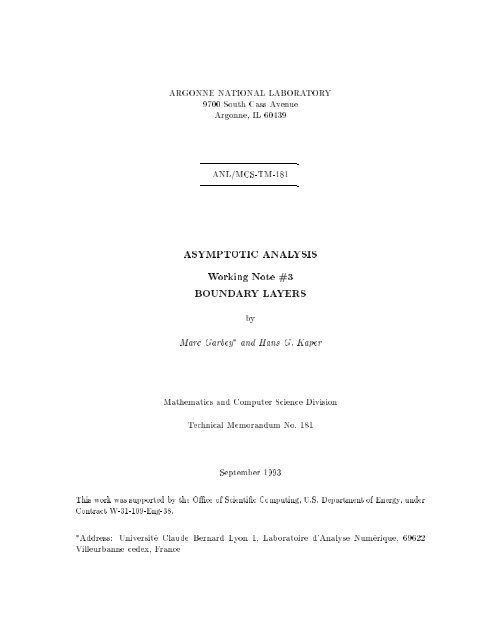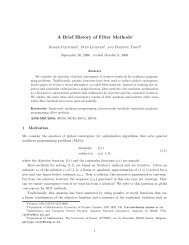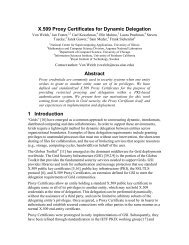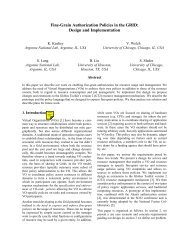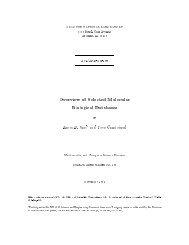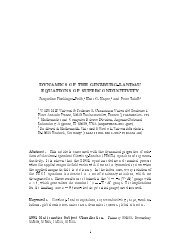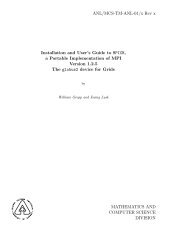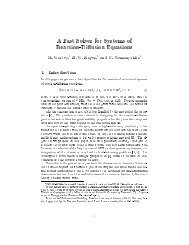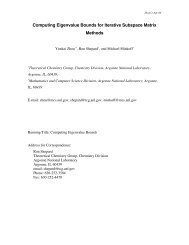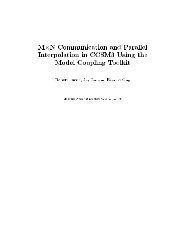ASYMPTOTIC ANALYSIS Working Note #3 BOUNDARY LAYERS
ASYMPTOTIC ANALYSIS Working Note #3 BOUNDARY LAYERS
ASYMPTOTIC ANALYSIS Working Note #3 BOUNDARY LAYERS
Create successful ePaper yourself
Turn your PDF publications into a flip-book with our unique Google optimized e-Paper software.
ARGONNENATIONALLABORATORY9700SouthCassAvenue|||||||||||- ANL/MCS-TM-181 Argonne,IL60439<strong>ASYMPTOTIC</strong><strong>ANALYSIS</strong>MarcGarbeyandHansG.Kaper <strong>BOUNDARY</strong><strong>LAYERS</strong> <strong>Working</strong><strong>Note</strong><strong>#3</strong> byMathematicsandComputerScienceDivision TechnicalMemorandumNo.181Villeurbannecedex,France ThisworkwassupportedbytheOceofScienticComputing,U.S.DepartmentofEnergy,under ContractW-31-109-Eng-38. Address:UniversiteClaudeBernardLyon1,Laboratoired'AnalyseNumerique,69622 September1993
methodsforthenumericalsolutionofboundaryvalueproblemswithcriticalparameters| thatis,parametersthatdeterminethenatureofthesolutioninsomecriticalway.Weare thinking,forexample,ofuidow(viscosity),combustion(Lewisnumber),andsuperconductivity(Ginzburg-Landauparameter)problems.TheirsolutionmayremainsmoothoverForsometime,wehavebeeninterestedinthedevelopmentandapplicationofasymptotic Prefacechangesoververyshortdistances.Shocklayersinuidowareavisiblemanifestationof thistypeofbehavior. region,thesolutionissmooth,butbetweensubregionsthesolutionundergoesdramatic awiderangeofparametervalues,butastheparametersapproachcriticalvalues,complicatedpatternsmayemerge.Boundarylayersmaydevelop,ortheregionoverwhichthesolutionextendsmaytakeontheappearanceofapatchworkofsubregions;oneachsub-parallelcomputingarchitectures,arebasedondomaindecomposition.Inadomaindecompositionmethod,onepartitionsthedomainintosubdomains,approximatesthesolutiononeachsubdomain,andassemblesthesesolutionstoobtainanapproximatesolutionon problemsincomputationalscience,andmucheortisbeingspentondevelopingnewtechniquesfortheirnumericalsolution.Someofthemostusefultechniques,inparticularontheentiredomain.Manycriteria,involvingconsiderationsfromlinearalgebratocomputer architecture,gointothedesignofausefuldomaindecompositionmethod.Ouraimisto Boundaryvalueproblemswithcriticalparametersposesomeofthemostchallengingasymptoticmethodsinthedesignofdomaindecompositionalgorithms. characterizeboundarylayers,transitionlayers,andinitiallayers;hence,ourideatouse exploretheuseofasymptoticmethods. valueproblemsinvolvingcriticalparameters.Itprovidesamethodologytoidentifyand Asymptoticanalysis,inparticularsingularperturbationtheory,isthestudyofboundaryH.G.KaperandM.Garbey,Lecture<strong>Note</strong>sinPureandAppliedMathematics{Vol.130, decomposition:aworkshopatArgonne,jointlysponsoredbytheDepartmentofEnergyand theNationalScienceFoundation(February1990),andaNATOAdvancedResearchWorkshopinBeaune,France(May1992).Proceedingsoftheseworkshopshavebeenpublished(Asymptoticanalysisandthenumericalsolutionofpartialdierentialequations,editedby entialequations,editedbyH.G.KaperandM.Garbey,NATOASISeriesC:Mathematical MarcelDekker,Inc.,NewYork,1991;Asymptoticandnumericalmethodsforpartialdier-WehaveorganizedtwoworkshopsonthesubjectofasymptoticanalysisanddomainandPhysicalSciences{Vol.384,KluwerAcademicPublishers,Dordrecht,Neth.,1993). variousrelevanttopics.Someofthenoteswillcontainnewmaterial;othersmayoernew presentationsofexistingmaterial.Wecertainlyexpectthenotestoevolveintime;the ourthoughtsbeforenalpublication,weintendtoproduceaseriesof<strong>Working</strong><strong>Note</strong>son Wecurrentlyhaveplanstodevelopafull-lengthbookonthesubject.Toformulate ii
MarcGarbey,Lyon,France HansG.Kaper,Argonne,Illinois,USA forourownuse,butwewillbehappytosupplycopiestointerestedcolleagues. notesmayormaynotappeareventuallyaschaptersofthebook.Thenotesareintended<strong>Working</strong><strong>Note</strong>#1: AsymptoticAnalysis|BasicConceptsandDenitions,ANL/MCS-TM-179(July1993) <strong>Working</strong><strong>Note</strong>#2: AsymptoticAnalysis|ApproximationofIntegrals,ANL/MCS-TM-180(July1993)iii
Contents Abstract 1Boundary-LayerBehavior 2ExtensionTheorems 14MatchingAsymptoticApproximations 3Regularization 1685Index 20iv
<strong>ASYMPTOTIC</strong><strong>ANALYSIS</strong> <strong>BOUNDARY</strong><strong>LAYERS</strong> MarcGarbeyandHansG.Kaper <strong>Working</strong><strong>Note</strong><strong>#3</strong>Abstract byweshallworkwithfunctionsthatareassumedtobegivenexplicitly|thatis,functions f:(0;0)!Xwhoseexpressionsareknown,atleastinprinciple.Onlyinthefollowing chaptershallwebeginthestudyoffunctionsthataregivenimplicitlyassolutionsof boundary-layerbehavior.Ourpurposehereistointroducethebasicconceptsunderlying thephenomenon,toillustrateitsimportance,andtodescribesomeofthefundamental toolsavailableforitsanalysis.Toachieveourpurposeintheclearestwaypossible, boundaryvalueproblems|therealstuofwhichsingularperturbationtheoryismade. Inthischapterwediscusstheasymptoticapproximationoffunctionsthatdisplay\almosteverywhere"|thatis,expansionsthatareregularoneverycompactsubset boundary-layeranalysisispurelylocalandaimsatconstructinglocalapproximations intheneighborhoodofeachpointofthesingularpartoftheboundary(Section3). Theproblemofndinganasymptoticapproximationisthusreducedtomatchingthe variouslocalapproximationstotheexistingregularexpansionvalidintheinteriorof ofthedomainofdenition,butnotneartheboundary(Section1).Theseregular asymptoticexpansionscanbecontinuedinacertainsenseallthewayuptotheboundary(Section2),butaseparateanalysisisstillnecessaryintheboundarylayer.TheBoundary-layerbehaviorisassociatedwithasymptoticexpansionsthatareregularWenowcontinuethediscussionoftheasymptoticapproximationoffunctionsbegunin 1Boundary-LayerBehavior Chapter2andturnourattentiontovector-valuedfunctionsthatdonothaveregularasymptoticexpansionsontheirentiredomainofdenition.Weassumethroughoutthischapterthatweareworkingwithfunctionswhoseexpressionsareknown,atleastinprinciple, tobetterexplainthephenomenonofboundary-layerbehavior;thediscussionofboundarylayerbehaviorforfunctionsthatareonlyknownimplicitlyassolutionsofsingularboundaryvalueproblemswillbegininthefollowingchapter.thedomain(Section4).1
fn:n=0;1;:::goforderfunctionsnandanontrivialsequenceffn:n=0;1;:::gof elementsfn2X,whichdonotdependon,suchthatthefunctionEf:(0;0)!X denedbytheexpressionEf()=Pnn()fnisanasymptoticapproximationoffonD. functionfhasaregularasymptoticexpansiononDifthereexistanasymptoticsequence functionsdenedonD,bymakingtheidenticationf()(x)=f(;x)forallx2D.The considerfasavector-valuedfunction,f:(0;0)!X,whereXisanormedspaceof f,whichisdenedon(0;0)D,whereDisaxed(-independent)domaininRN.We WerstrecallsomerelevantpointsofChapter2.Supposethatwearegivenafunctionuptoaspeciedorderofaccuracy.Theexpansioncoecientsfnareuniquelydetermined, wheref(0)()=f()andf(n)()=f()Pn1 The(regular)asymptoticexpansionmaybedeneduptoaspeciednumberoftermsor takeninX. applicationsmayrequiredierentasymptoticsequences. Observethattheasymptoticsequencefn:n=0;1;:::gdependsonf;indeed,dierent fn=lim #0f(n)()=n();n=0;1;:::;independentofandrequireinsteadthattheyareoftheorderO](1)as#0.Thisweaker Itissometimesadvantageoustoweakentheconditionthatthecoecientsfnbetotally p=0p()fpforn=1;2;:::.Thelimitsarepossiblethatitisregularonasubdomain. conditionleadstothetheoryofgeneralizedasymptoticexpansions.ThecoecientsfninDenition1Thefunctionf:(0;0)!XhasaregularasymptoticexpansiononasubdomainD0ofDifthereexistanasymptoticsequencefn:n=0;1;:::goforderfunctionpansionsextendstogeneralizedasymptoticexpansions,butweprefertoavoidthetechnicalcomplicationsandwillnotconsidergeneralizedexpansions. suchexpansionsarenotunique.Muchofwhatwewillsayaboutregularasymptoticex-,suchthatthefunctionE0f:(0;0)!X,denedbytheexpressionE0f()=Pnn()fn andanontrivialsequenceffn:n=0;1;:::gofelementsfn2X,whichdonotdependon IftheasymptoticexpansionofffailstoberegularontheentiredomainD,itisstillD0needtobeconsidered. isanasymptoticapproximationoffonD0.Lemma1LetfhaveregularasymptoticexpansionsE0fandE1fonthesubdomainsD0 andD1ofD,respectively.IfD0D1,thenE0fextendsE1ftoanasymptoticapproximationoffonD0.inducedonD0bythenormofX,butonlytherestrictionsofthefunctionsf(n)()=n()to fnareuniqueandtheyarefoundbytakinglimits.Thelimitsmustbetakeninthetopology Again,iffhasaregularexpansiononsomesubdomainD0ofD,itsexpansioncoecients2
toticexpansionwithrespecttotheasymptoticsequence. byaregularasymptoticexpansion\almosteverywhere"onD. Proof.Animmediateconsequenceoftheuniquenessofthecoecientsinaregularasymp-Denition2Thefunctionf:(0;0)!Xexhibitsboundary-layerbehavioronDifthere subsetofD,butthereisnoregularasymptoticexpansionapproximatingfonD. existsaregularasymptoticexpansionEfapproximatingfonevery-independentcompact Functionsthatdisplay\boundary-layerbehavior"arefunctionsthatareapproximatedbehaviorwasnotconnedtouiddynamics,butthatitisindeedawidespreadphenomenon causedby\singularperturbations"inthemathematicalmodel.Theterminologyhasbeen generallyadoptedtolooselydescribethebreakdownofregularitynearboundaries. developmentsincontinuummechanicsrevealedthatthephenomenonofboundarylayer athinlayerneartheboundary,aphenomenonrststudiedbyPrandtlin1904[1].Later viscousuidnearaboundary,theviscositycausesrapidvariationsoftheuidvelocityin Theterminology\boundarylayer"hasitsorigininuiddynamics.Inthemotionofaeverywherealongtheboundary.Thus,theboundaryistheunionoftwodisjointsets,the \regularpart"andthe\singularpart." Denition3ApointP2@Dbelongstotheregularpartoftheboundary,@rD,ifthe -independentcompactsubsetofD[P.EverypointP2@Dthatdoesnotbelongtothe regularasymptoticexpansionEfextendstoanasymptoticapproximationoffonevery Boundarylayerscanoccuranywherealongtheboundaryanddon'thavetohappenregularpartoftheboundarybelongstothesingularpartoftheboundary,@sD. designatedasaboundarylayer.Theterminologyisvagueandsomewhatqualitative. f02X,givenbyf0(x)=1forallx0,denesaregularapproximationas#0onevery f(;x)=1ex=for0x
andthetopologyisdenedintermsofuniformconvergence,asintheexample.So,allone hastodoisweakenthetopologyandadmitgeneralizedfunctionstotheclubofpotential expansioncoecients.Ofcourse,theargumentiscorrect|fromthetheoreticalpointof smallparameterdecreasesto0|forexample,whenXisaspaceofcontinuousfunctionsshownotonlyhowonecanlivewithit,butevenhowonetakeadvantageofit. notnecessarilyimplythatitisinnitesimallysmall.Forallthesegoodreasonswewillstick withthetopologythatcausestheboundary-layerbehaviorand,ifallgoeswell,wewill solutionisessentialinthecontextofapplications,anduniformerrorestimatesdomake beevaluatedpointwiseandaredenedcontinuouslyeverywhere.Thenotionofaclassical senseinnumericalcomputations.Furthermore,thefactthatisasmallparameterdoes view.Butfromthepracticalpointofviewitmakessensetoconsiderfunctionsthatcanvariablet(usuallyt=0),wemayrefertoitasaninitiallayer. ;ifi6=j,wemayndaboundarylayeralongthecommonboundaryoftwoadjacent subdomains.Insuchcases,wemayrefertotheboundarylayerasatransitionlayer. Afewmoreremarksaboutboundarylayers.(Sometimes,theterminternallayerisused.) Ifaboundarylayeroccursalongamanifoldthatisdescribedintermsofatimelike IfDistheunionofanitenumberofdisjointsubdomains,D=[iDiwithDi\Dj=deneD1=(1;0)andD2=(0;1)andputD=D1[D2.LetXbethenormed Foranelementaryexampleofatransitionlayer,considertheboundaryvalueproblemvectorspace(C(D);kk1),andconsideruasamapfrom(0;0)intoXbymakingthe usualidentication,u()(x)=u(;x)forallx2D.Thefunctionu02Xwithvalues u(;x)=tanh(x=)for1
itsapplicationtothenumericalsolutionofboundaryvalueproblems|themainobjective transitionlayers,hasmademuchprogress,butremainsthedomainofafew.Inparticular, ofthisbook|islargelyundeveloped. Exercises 1.Considertheboundaryvalueproblem diusionphenomena;thecoecientmeasurestherateofdiusion. (i)Verifythatthesolutionofthisboundaryvalueproblemisgivenbytheintegral whereisagivenfunction.Thislinearboundaryvalueproblemisasimplemodelforallsortsof jxj!1u(t;x)=0;t2(0;1);u(0;x)=(x);x2(1;1); limu(;t;x)=1ut=uxx;(t;x)2(0;1)(1;1);2ExtensionTheorems (ii)Discusstheasymptoticbehaviorofuas#0. (4t)1=2Z1 1(y)exp(xy)2 4tdy:Supposethatfhasboundary-layerbehaviorinD.Thenthereexist-independentelements f0;f1;:::inXsuchthatthefunctionEf=Pnnfnisanasymptoticapproximationoff onanycompactsubsetKofD.IftheboundaryofDhasaregularpart@rD,thenEf extendstoanasymptoticapproximationoffonevery-independentcompactsubsetof D[@rD.However,EfdoesnotextendtoanasymptoticapproximationoffonD,because toextendEfupto@sDinawelldenedsense.Theextensiontheoremsthatweestablish ofthepresenceofthesingularpartoftheboundary,@sD.Ontheotherhand,itispossible inthissectiongeneralizearesultofKaplun[4,5]andareaconsequenceofthefollowing simplelemma.Proof.Itfollowsfrom(ii)that,foranyp>0andanyxedd2(0;d0),wehaveg(;d)0,andfpn:n=1;2;:::g,bothmonotonicallydecreasingtoward0,andusingthedenition oftriples,f(dn;pn;qn):n=1;2;:::g,startingfromtwosequencesfdn:n=1;2;:::g of(i),q(;p)isnondecreasing;furthermore,limd#0q(d;p)=0.Wenowformasequence 5
functionthatsatisestherelation(qn)=dn1forn=2;3;:::satisestheconditionsof qn=minfq(pk;dk):k=1;2;:::;n;1=ngtodeterminethethirdelementofeachtriple. Theng(;d)
em.Itshowsthatonecansometimessacricesomeoftheaccuracyofanasymptotic actuallyhappensnear0remainsundisclosed. approximationtogainanextensionofitsdomainofvalidity. thatfhasaregularasymptoticapproximationon(0;1)inthesenseofthetheorem,whatTheorem2Suppose@sDiscompactandEfisanasymptoticapproximationoftheorder ofm1(i.e.,Efisaregularexpansiontomterms)offonany-independentcompact subsetofD[@rD.Thenthereexist,foreachp2f0;:::;m1g,anorderfunction0p AnotherinterestingapplicationofLemma2isgiveninthefollowingextensiontheo-satisfyingdist(K0p();@sD)=0p(),suchthatEfextendstoanasymptoticapproximationof forp=1;:::;m1. theorderofm1poffonK0p().Theorderfunctions0psatisfytherelation0p=O(0p1) Proof.IffEf=o(m1)onanycompactsubsetofD[@rD,thencertainlyfEf= o(m1p)forp=0;:::;m1onthesamesubset.Theproofofthetheoremissimilarto satisfying0p=o(1)andanestedfamilyfK0p():2(0;0)gofcompactsubsetsofD[@rDsucestotake0p=0p1toprovethelastassertionofthetheorem. theproofofTheorem1,whereinthenalstepwetakeg(;d)=k(1=m1p)(fEf)k.It anyextensionatall.Thepointis,however,thatitmayjustbepossibletosharpenthe pointinglysimple;infact,thebottomlineisthatbytaking0p=0p1wedonotachieve estimate0p=O(0p1)to0p=o(0p1)andthusobtainarealextensionofEf,albeitatthe f(;x)=(+x)1on[0;1)asamappingfrom(0;0)intoX=(C[0;1);kk1).The priceofareductionintheorderofaccuracy. Hereisasimpleexample,whereallthedetailscanbeworkedout.Considerthefunction Althoughthestatementofthetheoremisimpressivelycomplicated,itsproofisdisap-form[ap=(m+1);1).Theleftendpointofthisintervalactuallygetscloserto0aspincreases, whileisbeingkeptxed.Thus,arealextensionofEfisobtained.Inthenotationof Theorem2,wehave0p()=p=(m+1)and,indeed,0p=o(0p1)forp=1;:::;m1. remaindercanbecalculatedexplicitly,(fEf)(;x)=(1)mmxm(+x)1,andone readilyveriesthat,foreachp2f0;:::;m1g,fEf=o(m1p)onanyintervalofthe m-termexpansionEf(;x)=Pm1 oftheorderofm1off,fEf=o(m1),onanyinterval[a;1)witha>0.The n=0(1)nnxn1denesanasymptoticapproximationExercises 1.ProvethefollowingcounterpartofLemma2. d0,andletgsatisfytheproperties(i)g(;)ismonotonenondecreasingforeach2(0;0),and(ii) Lemma3Letthefunctiongbepositiveon(0;0)(d0;1)forsome0>0andsomerealnumber 7
2.ProvethefollowingcounterpartofTheorem1. extendstoanasymptoticapproximationoffonK1=()=D\B1=(). familyfB1=():2(0;0)gofballsofradius1=()centeredattheorigininRN,suchthatEf subsetKR=D\BRofD.Thenthereexistanorderfunctionsatisfying=o(1)andanested Theorem3LetBRdenotethe(open)ballofradiusRcenteredattheorigininRN.SupposeDis lim#0g(;d)=0foreachd2(d0;1).Thenthereexistsanorderfunctionsatisfying=o(1),such unboundedandfhasaregularasymptoticexpansionEf=Pnnfnonevery-independentcompact thatlim#0g(;1=())=0.3.ProvethefollowingcounterpartofTheorem2.4.ProvethefollowingextensionofLemma3. expansiontomterms)offonevery-independentcompactsubsetofKR=D\BRofD.Then isunboundedandEfisanasymptoticapproximationoftheorderofm1(i.e.,Efisaregular thereexist,foreachp2f0;:::;m1g,anorderfunction0psatisfying0p=o(1)andanestedfamily functions0psatisfytherelation0p=O(0p1)forp=1;:::;m1. fB1=0p():2(0;0)gofballsofradius1=0p()centeredattheorigininRN,suchthatEfextends Theorem4LetBRdenotethe(open)ballofradiusRcenteredattheorigininRN.SupposeDnumberd0,andletgsatisfytheproperties(i)g(;)ismonotonenondecreasingforeach2(0;0), and(ii)lim#0g(;d)=0foreachd2(d0;1).Thenthereexistsanorderfunctionsatisfying =o(1),suchthatlim#0g(;1=())=0. Lemma4Letbeareal-valuedfunctionon(0;0),whichgrowsbeyondboundsas#0.Letthe functiongbepositiveonthesetf(;d):2(0;0);d2(d0;())gforsome0>0andsomereal toanasymptoticapproximationoftheorderofm1poffonK1=0p()=D\B1=0p().Theorder5.ProvethefollowingextensionofTheorem3. 6.LetX=C([0;1);kk1),andlet2XhaveaconvergentTaylorseriesexpansion(x)=P1i=0aixi hasaregularasymptoticexpansionEfoneverycompactsubsetD=D\BofD.Thenthereexist Theorem5Letbeareal-valuedfunctionon(0;0)whichgrowsbeyondboundsas#0,andlet Bdenotethe(open)ballofradius()centeredattheorigininRN.SupposeDisunboundedandf forallx2[0;1).Considerthefunctionf(;x)=(x)asamapfrom(0;0)intoX.FindthemtermasymptoticexpansionEfoffandverifythatitcanbeextendedtoanasymptoticapproxiationanorderfunctionsatisfying=o(1)andanestedfamilyfB1=():2(0;0)gofballsofradius 1=()centeredattheorigininRN,suchthatEfextendstoanasymptoticapproximationoffon oftheorderofm1p(p=0;:::;m1)onanyinterval[0;bp=m],whereb>0.(Cf.Theorem4.) K1=()=D\B1=().comefromalocalanalysis. insightastowhatactuallyhappensinsidetheboundarylayer.Thisinformationcanonly 3Regularization Theextensiontheoremsareimportantforthedevelopmentofsingularperturbationtheory, butoflimitedpracticaluse.First,theyaretypicalexistencetheorems;theydonotsay anythingabouttheorderfunction,exceptthatitiso(1).Second,theydonotgiveany 8
stretchedoutinthetransversedirectionacrosstheboundarylayer.Infact,theamountof stretchingmustincreaseasdecreases,tocounteractthe\thinning"oftheboundarylayer. So,ifwewanttondoutwhatactuallyhappensinsidetheboundarylayer,wemustlook onadierentscale|thatis,introduceanewindependentvariable|,wherethingsare layersoccurbecausethefunctionunderdiscussionundergoesrapidvariationsnearthe singularpartoftheboundary,andthesevariationshappenoneversmallerscalesas#0. Theideabehindthelocalanalysisthatweareabouttopresentisfairlysimple.Boundaryconsiderationandmayvaryfromonecomponentofthesingularpartoftheboundaryto another.Ingeneral,thenewvariable,y,willbeafunctionofandtheoldvariablex, centeredatPinRN.)Usually,onedenesinsuchawaythatPissenttotheorigin,so y=(;x)say.IfP2@sDisarepresentativepointontheparticularcomponentof somesubsetDP=D\BR(P)ofDwithR>0.(BP(R)istheopenballofradiusR analysis,thenmustbesucientlyregular(forexample,ahomeomorphism),atleaston thesingularpartoftheboundarynearwhichwewishtoperformalocalboundary-layer Thechoiceofthenewindependentvariabledependsofcourseonthefunctionunderbeyondboundsas#0.If(DP)istheimageofthesetDPunderthechangeofvariables, (DP)=f(;x):x2DP;2(0;0)g,then(DP)lookslikeasemi-innitecylinderbased attheorigin. mapsaone-dimensionalboundarylayernearx=xPontoanintervalwhoselengthgrows (;xP)=0,andisalinearfunctionofx.Forexample,y=(xxP)=()with=o(1)functionson(DP),whoseasymptoticbehavioras#0canbeanalyzedintheframework ofY.SincethedependenceofTfupondiersfromthedependenceoffupon,there isachancethatTfhasaregularasymptoticexpansionon(DP)andthattheorigin asamappingTf:(0;0)!Y,whereYisanappropriatelydenednormedvectorspaceof throughtheformulaTf(;y)=Tf(;(;x))=f(;x).Thisfunctioncanbeinterpreted belongstotheregularpartoftheboundary.(RecallthattheoriginistheimageofPunder Thechangeofvariablesy=(;x)transformsfintoanotherfunction,Tfsay,ofandy Now,considertheeectofsuchatransformationonf,whichisafunctionofandx.transformeverythingbacktoDPbymeansoftheinversetransformation1.Theresult isanexpansionoff,whichisalocalasymptoticapproximationoffnearP. achievedaregularizationoffatP.WecanconstructtheregularexpansioninYandthen thechangeofvariables;itisaboundarypointof(DP).)Ifthisisthecase,wehavebeworkedout.Theexampleisagainprovidedbythefunctionf(;x)=1ex=on layernear0.Thetransformationy=(;x)=x=mapstheinterval[0;1)ontoitself, beunique,butthisalldependsonthefunctionf. [0;1),which,consideredasamapfrom(0;0)intoX=(C[0;1);kk1),hasaboundary andwecantakeY=X.Thetransformationsinducearegularizationoffnear0, Ofcourse,thereisnoguaranteethataregularizationexists,andifitexistsitmaynotTf(;y)=1eyfory2[0;1).ThefunctionTfisindependentofandistherefore Beforemovingontothedetails,wediscussasimpleexample,whereeverythingcan9
identicalwithits(regular)asymptoticexpansiononitsentiredomainofdenition.The inversetransformationx=1(;y)=yyieldstheexpansionE0f(;x)=1ex=,whichToavoidextraneoustechnicalcomplications,weassumethatthiscomponentisasmooth theboundaryofDmayconsistofseveralcomponents,eachofwhichneedstobeanalyzed separately,butthroughoutthefollowingdiscussionwefocusononesinglecomponent. isalocalasymptoticapproximationoffoneverycompactsubintervalof[0;1).Pbearepresentativepointonthismanifold.ThepositionvectorofPisxP=(xP1;:::;xPN), (N1)-dimensionalmanifold,wherethenormaldirectioniswelldenedateachpoint.Let Wenowturntothedetailsofalocalboundary-layeranalysis.thetangentspaceatthepointPisspannedbytheunitvectorstP1;:::;tPN1,andtheunit normalvectoratPisnP.Fordeniteness,weassumethatnPpointsintoD;ifPis Supposef:(0;0)!Xhasboundary-layerbehavioronD.Thesingularpart@sDofasymptoticapproximationoffon-dependentcompactsubsets,possiblywithsomeloss compactsubsetofD[@rD.Aswehaveseenintheprevioussection,Efextendstoan asymptoticapproximationoffonthecompactsubsetK0pofD[@rDforsome0psatisfying oftheorderofaccuracy.WeassumethatthisextensionhasbeendoneandthatEfisan identiedwithatransitionlayer,wetreateachsideoftheboundaryseparately. 0p=o(1).ThedistancefromPtoK0pisO](0p). LetEf()=Pnn()fnbetheregularasymptoticexpansionoffonevery-independentdirection.Thechangeisaccomplishedbyan-dependenttransformation, followedbyan-dependentlineartransformation;inexceptionalcases,itmaybenecessary togeneralizetoageneralhomeomorphism.Ineithercase,onemustassumethat()is Inmostcases,()canbeananetransformation|thatis,ashifttoputPattheorigin, Asarststep,wechangevariablestomagnifytheboundarylayerinthe\thin"(normal)theopenballofradiusRcenteredatPinRN.)Tokeepthingssimple,wewilltake denedonsomesubsetDP=D\BR(P)ofDandcontinuouslyextendedtoP.(BR(P)is ():x7!y=(;x):multiplicationby1=inthedirectionofthenormalvectoratP,forsome2E, icallyequaltothedirectsumoftheidentitymatrixonthetangentspaceandascalar where:(0;0)7!RNN k()tPik=O](1);i=1;:::N1;k()nPk=O](1=()): +isanonsingularmatrix-valuedfunction,whichisasymptot-(;x)=()(xxP);x2DP;=o(0p),toprovide()withsucientmagnicationintheboundarylayeras#0. Here,kkistheEuclidianlengthinRN.Werequirethatsatisfytheorderrelation 10
Thetransformations()formafamily,lookslikeanopencylinder,whosecrosssectionremainsasymptoticallythesame,butwhose dimensionintheaxialdirectionisstretchedmoreandmoreas#0. [()(DP),saythatisoftheorderof1=,andwrite=O](1=). whichweassumetobeordered,(1)(DP)(2)(DP)whenever12.Weput(DP)= Arstobservationisthat(DP)isanunboundedsubsetofRN.Infact,()(DP) =f():2(0;0)g;induction,totheboundary@(DP)of(DP).Intheimageofthepreviousparagraph,the layer(thatis,allpointsbelongingtothedomainofvalidityoftheinteriorapproximation originisatthecenterofthebaseofeverycylinder. Efoff)aresenttoinnity.Consequently,thepre-imageofany-independentcompact subsetof(DP[P)=(DP)[0isasubsetoftheboundarylayernearP. Third,becausewehavegivensucientmagnication,allpointsbeyondtheboundary Second,theoriginbelongstotheboundaryof()(DP)forevery2(0;0)andso,byrestrictionstoDP. Now,weconsidertheeectofthetransformationonelementsofX,orrather,theirlimitsandtheirpropertiescanbefound,forexample,in[6,SectionXI.5]. domain(DP).Thetoolweuseisthatoftheinductivelimit;adiscussionofinductive gumentsistoconstructanormedvectorspaceYPoffunctionsdenedonthe-independent intofunctionsdenedon()(DP),whichis-dependent.Thepurposeofthefollowingar-is-independent.Butbyapplyingthecoordinatetransformation(),wetransformthem inducedbythenormofX.ElementsofXParefunctionsdenedonthedomainDP,which LetXPdenotethenormedvectorspaceoffunctionsdenedonDPwiththetopologythatiscommensuratewiththenorminX, forsome2XP.WemakeYP()intoanormedvectorspacebyintroducinganormkkY LetYP()bethesetofallfunctions (y)= k ((;x))=(x);y2()(DP); kY=kkX;2XP: denedon()(DP)bytheidentityintuitiveideathatweendupwithanormedvectorspaceYPoffunctionsdenedonan ThespacesfYP():2(0;0)gformanestedfamilyofnormedvectorspaces,becauseof Again,theprecisedetailsofthisconstructionarelessimportant;whatisimportantisthe theorderingwithinthefamily.TheirinductivelimitdenesthespaceYP, YP=limind#0YP(): 11
-independentdomainandthatwehaveaframeworktorelateelementsofXP(functions Letusseewhatthistransformationdoestotherestrictionoff()toDP.Foreach2(0;0), denedonDP)toelementsofYP(functionsdenedon(DP)).Therelationabovebetween thefunctions2XPand weobtaintheelementTf()2YP,soifwedothisforevery2(0;0),weobtainanew vector-valuedfunction,TPf:(0;0)!YP, (T)(y)=(x);y=(;x);x2DP;2XP: 2YPdenesatransformationT:XP!YP,theasymptoticbehavioroffnearP.(RecallthatPismappedintotheorigin,sowewill ThefunctionTPfgivesusindirectaccesstof,andourgoalistouseTPftoinvestigate Thepointwiseexpressionis (TPf)(;y)=f(;x);y=(;x);x2DP;2(0;0): (TPf)()=Tf();2(0;0):payparticularattentiontothebehaviorofTPfneartheorigin.) Denition4ThetransformationisaregularizingtransformationforfatPiftheorigin YP.ThefunctionTPfdenedbyaregularizingtransformationiscalledaregularization offatP. belongstotheregularpart@r(DP)oftheboundaryof(DP)forthefunctionTPf:(0;0)! (TPf)n2YPforn=0;1;:::Thetilde~indicatesthattheexpansiondenesanasymptotic approximationinYP. ~ETPf()=Pnn()(TPf)nonevery-independentcompactsubsetof(DP)[0,where Thus,ifTPfisaregularizationoffatP,thenTPfhasaregularasymptoticexpansionon[0;1).Thisfunction,consideredasamappingfrom(0;0)intoX=C([0;1);kk1), hasaboundarylayerat0(P=0).Eachtransformation()(x)=x=with0maps regularizesthefunction(1ex=)sin(1=x)at0.Also,ifaregularizationexists,itisnot necessarilyunique.Again,weillustratewithanexample, Aregularizationmayormaynotexist.Forexample,thereisnotransformationthattheinterval[0;1)ontoitselfandYP=XP=X.Wehave TPf(;y)=1y+q22y2+21+1: f(;x)=(x=)+q(x=)2+2=+1;If00; if12,thenTPf()1=2f0;withf0;(y)=y+p2+y2if=12andf0;(y)=p2if
12onanycompactinterval[0;b]withb>0.Thus,everytransformationwith12 denesaregularizationTPfoffat0. moresignicant,becauseitgivesmoreinformationatlessmagnifyingpowerthanthesame transformationwith>12. inducearegularization. ingthanothers:onehasthefeelingthatthetransformationwith=12issomehow Wecancomparethemagnicationofdierenttransformationsandthustheirabilityto Ascanbeseenfromtheexample,someregularizingtransformationslookmorepromis-Lemma5SupposeinducesaregularizationoffatP,and=O](1=).TheneveryDenition5Asignicantregularizationoffisinducedbyanytransformationwith familiesand0andtheorderrelation0=o(). Proof.Theassertionofthelemmaisanimmediateconsequenceoftheorderingwithinthe transformation0whichisO](1=0)with0=o()inducesanotherregularizationoffatP.fatthesamepoint,whichsatisestheorderrelation0=O](1=0),then0=o().A minimalorder|thatis,if=O](1=)and0isanotherregularizingtransformationfor variablef(;x):x2Dgthatdenesasignicantregularizationiscalledaboundary-layer variable.existenceofaregularizationisinnowayguaranteed;infact,thecharacterizationofthe formerandsimplyrefertotheformeras\regularizations."Werepeat,however,thatthe andwillusuallybetheonesofinterest.Weshallthereforeignorethelatterinfavorofthe yieldenoughdetail.Theboundarylayervariableisy=x1=2. with=12;lessmagnicationdoesnotyieldaregularization,moremagnicationdoesnot Signicantregularizationsareobviouslymoresignicantthanordinaryregularizations Intheexampleabove,thesignicantregularizationisinducedbythetransformationclassoffunctionsfforwhicharegularizationexistsisanopenandinterestingproblemof ponentof@sD,butvaryfromonecomponenttoanotherif@sDconsistsofmorethanone asymptoticanalysis.transformationoftheorderO](r),andlet~ETPf()=Pnn()(TPf)nbetheregular component.Itthenbecomesamatterofpiecingthevariousregularizationstogetherto arriveataglobalregularization. The(signicant)regularizationwillgenerallybethesameatpointsonthesamecom-NowsupposethatwehavefoundaregularizationTPfoffatPthrougharegularizing 13
asymptoticexpansionofTPfonevery-independentcompactsubsetof(DP)[0.(Werecallthatrsatisestheorderrelationr=o(0p),where0pisameasureofthethicknessoftheboundarylayer.)Aswehaveseenintheprevioussection,theasymptoticapproximationdenedby~ETPfextendsto-dependentcompactsubsets,possiblywithsomelossoftheorderofaccuracyifonegoesforthelargestpossibledomain.(Inthepresentcase,theextensionprocessmustbebasedonTheorem3,oritsgeneralizationTheorem4,becausetheset(DP)isunbounded.)Letusformulatetheresultoftheextensioninpreciseterms.Suppose~ETPfisanasymptoticapproximationoftheorderofn1ofTPf(i.e.,~ETPfisann-termasymptoticexpansion).Thenthereexist,foreachq2f0;:::;n1g,anorderfunction00qsatisfying00q=o(1)andanestedfamilyfB1=00q():2(0;0)gofballsofradius1=00q()centeredattheorigininRN,suchthat~ETPfextendstoanasymptoticapproximationoftheorderofn1qofTPfon~K1=00q=((DP)[0)\B1=00q().Theorderfunctions00qsatisfytherelation00q=O(00q1)forq=1;:::;n1;possibly,thisorderrelationcanbesharpenedtoao-relation.IfwetransfertheseresultstothespaceXPbymeansofthetransformationT1P,weobtainthefollowingtheorem.Theorem6SupposeTPfisaregularizationoffatPand~ETPfisitsasymptoticapproximationoftheorderofn1(i.e.,~ETPfisann-termasymptoticexpansion)onany-independentcompactsubsetof(DP)[0.Thenthereexist,foreachq2f0;:::;n1g,anorderfunction00qsatisfying00q=o(1)andanestedfamilyfB(r=00q)()(P):2(0;0)gofballsofradiusr()=00q()centeredatPinRN,suchthatT1P~ETPfisanasymptoticapproximationoffonK(r=00q)()=(DP[P)\B(r=00q)()(P).Theexpansions~ETPfandT1P~ETPfhavethesamenumberoftermsanddeneasymptoticapproximationstothesameorderofaccuracy.Proof.IfweapplyT1Ptotheregularasymptoticexpansion~ETPf,weobtainthefunctionT1P~ETPfinXP,whichisanexpansionoff,althoughnotnecessarilyaregularasymptoticexpansion.If~ETPfisanasymptoticapproximationofTPfofacertainorderofaccuracyorofacertainnumberoftermsonsomecompactsubsetof(DP)[0,thenT1P~ETPfisanasymptoticapproximationoffofthesameorderofaccuracyorthesamenumberoftermsonthepre-imageofthesetunderthetransformation.ThefactthattheorderofaccuracydoesnotchangeisanimmediateconsequenceofthefactthatthenormsinXPandYParecommensurate.Thepre-imageofacompactsubsetof(DP)[0isacompactsubsetofDP[P,andthepre-imageofaballofradius1=q()centeredattheorigininRNisa\attenedball"centeredatPinRN,whosedimensionsareasymptoticallyoftheorderO](1=00q)inthetangentialdirectionsandO](r=00q)inthenormaldirection.14
entirelywithintheboundarylayernearP;theylltheboundarylayerinthenormal directionas#0. expansioncanbetoaspeciednumberoftermsortoaspeciedorderofaccuracy.Ifis anasymptoticapproximationoffintheboundarylayernearP.Wedenotetheextension byEPfandrefertothefunctionEPfthusdenedasalocalexpansionoffnearP.The Byimposingtheconditionr=o(00 WemaysummarizethestatementofthetheorembysayingthatT1 q),weachievethatthesubsetsK(r=00 P~ETPfextendsto q)()arelocatedtheregularizingtransformationthatdenesTPf,thenwehavethepointwiseexpression Thefunctions(TPf)nareuniquelydetermined;theyareobtainedbytakinglimitsinY, EPf()(x)=EPf(;x)=Xnn()(TPf)n(y);y=(;x);x2DP: (TPf)n=lim #0(TPf)(n)()WeconcludewithasimpleexampletoillustrateTheorem6. 1;2;:::Pointwise, where(TPf)(0)()=(TPf)()and(TPf)(n)()=(TPf)()Pn1 (TPf)()(y)=(TPf)(;y)=f(;x);y=(;x);x2DP[P: n();n=0;1;:::;Considerthefunctionf(;x)=ex=+(x)on[0;1),wherehasaconvergentTaylor p=0p()(TPf)pforn=thelocalexpansionEPf(;x)=ex=+Pn1 form[0;bq=n].Whenwetranslatetheseresultsbacktotheoriginalvariable,weobtain alsohave,foreachq2f0;:::;n1g,TPf~ETPf=o(n1q)onanyintervalofthe attheorigin,TPf(;y)=ey+(y),andtheasymptoticapproximationtotheaccuracyof seriesexpansionforallx,(x)=P1i=0aixi.Asusual,weconsiderthisfunctionasa n1is~ETPf(;y)=ey+Pn1 O](n)=o(n1)onanyinterval[0;b]withb>0.But,inagreementwithTheorem6,we mappingfrom(0;0)intoX=(C[0;1);kk1).Thetransformationy=x=regularizesf i=0aiiyi.TheremaindersatisestheestimateTPf~ETPf=Exercises ofTheorem6,wehave00 intervalalwaysgoestozeroas#0,buttheratedecreasesasqincreases.Inthenotation estimatefEPf=o(n1q)onanyinterval[0;b1q=n].Noticethatthelengthofthis q()=q=n. i=0aixiforf,whichsatisestheasymptotic1.Considerthefunctionf(;x)=2(x+2)1ex=for0x
Wenowcometotheimportantproblemofmatchinglocalexpansionsvalidintheboundary layertotheinteriorexpansionvalidinD. 4MatchingAsymptoticApproximationsnearP,asdescribedbyTheorem6.ThentwothingsareneededtomatchEPftoEIf:(i) andletEPfbethelocalasymptoticapproximationobtainedthrougharegularizationoff EIfandEPfneedtoshareacommondomainofvalidity,and(ii)EIfandEPfneedto partoftheboundaryofD.LetEIfbetheasymptoticapproximationoffobtainedby approximatingDfromwithin,asdescribedinTheorem1oritsgeneralization,Theorem2, havecommensurateordersofapproximation.Letusconsiderthesituationinmoredetail. Supposefhasboundary-layerbehavioronDandPisapointon@sD,thesingularasymptoticexpansionEfoff,wehaveproventheexistenceoforderfunctions0;:::;0m1, thatthesymbolOmaybestrengthenedtoo,inwhichcasethecompactsubsetsactually expandaspincreaseswhileisbeingkeptxed. dist(K0p;@sD)=O](0p),suchthatfEf=o(m1p)onK0p()forp=0;:::;m1.The allo(1)as#0,andofnestedsetsofcompactsubsetsK0();:::;K0m1()satisfying orderfunctionssatisfytherelation0p=O(0p1)forp=1;:::;m1,butitisnotruledout First,welookatEIf.ArguingfromwithinDandstartingfromanm-termregularregularizingtransformation(i.e.,achangeofcoordinates)oftheorderof1=r.Byimposing aregularizationTPfoffnearP.Letusassumethatithasbeenobtainedthrougha theconditionr=o(0p)forp=0;:::;m1,wehaveachievedthattheentiredomainof validityoftheinnerexpansionissenttoinnitybytheregularizingtransformation.Then, startingfromann-termregularasymptoticexpansion~ETPfofTPf,wehaveproventhe existenceoforderfunctions00 Next,considerEPf.ThefactthatwetalkaboutEPfpresupposesthatthereexistsnearPinthenormaldirectionas#0,suchthatfT1 subsetsK(r=00 0)();:::;K(r=n1)00(),eachcontainingPandallllingtheboundarylayer 0;:::;00 n1,allo(1)as#0,andofnestedsetsofcompactthecompactsubsetsactuallyexpandasqincreaseswhileisbeingkeptxed. but,again,itisnotruledoutthatthesymbolOmaybestrengthenedtoo,inwhichcase directionsandO](r=00 0;:::;n1.Theorderfunctionssatisfytheorderrelation00 forq=0;:::;n1.ThedimensionsofthesetK(r=00 Giventhesedetails,letusrstconsiderthemoststraight-forwardcase,wherem=n q)inthenormaldirection.Weassumethatr=o(00 q)()areO](1=00 P~ETPf=o(n1q)onK(r=00 q=O(00 q1)forq=1;:::;n1, q)inthetangential q)forq= q)()andp=q=0. Denition6ThefunctionfanditsregularizationTPfatPsatisfythestrongoverlap conditioniftheintersectionoftheextendeddomainofvalidityofthem-terminteriorexpansionEIfandtheextendeddomainofvalidityofthem-termlocalexpansionEPfhasa16
conditionif,foreverym=1;2;:::,thereexistorderfunctions0and00 Theorem7ThefunctionfanditsregularizationTPfatPsatisfythestrongoverlap nonemptyinteriorforeverym=1;2;:::toTheorem6,them-termexpansionEPfextendstoanasymptoticapproximationoff approximationoffonK0().Thedistancefromthissetto@sDisO](0()).According o(r=00 onK(r=00 Proof.AccordingtoTheorem2,them-termexpansionEIfextendstoanasymptotic 0). 0)().ThelattersetextendsoveradistanceO](r=00 0)())fromPintoDinthe 0suchthat0=normaldirection.If0=o(r=00 isnostrongoverlap,itbecomesamatterofbalancingtheaccuracyofeachapproximation (i.e.,thenumberoftermsintheexpansion)againstthedomainofvalidity,andwemay andEPfattheexpenseofaccuracy.Obviously,thisisthebestofallpossibleworlds.Ifthere havetoincreasethenumberoftermsineitherorbothoftheexpansionstoachievethe Inthecaseofstrongoverlap,thereisnoneedtoextendthedomainsofvalidityofEIf 0),thetwosetscertainlyoverlapas#0.desiredorderofaccuracyintheregionofoverlap.Theorem8ThefunctionfanditsregularizationTPfatPsatisfytheoverlapcondition oftheextendeddomainofvalidityofthem-terminteriorexpansionEIfandtheextended domainofvalidityofthen-termlocalexpansionEPfhasanonemptyinterior,wheref EIf=o(k1)andfEPf=o(k1). if,foreveryk=1;2;:::,thereexistintegersm;n2fk;k+1;:::gsuchthattheintersection Denition7ThefunctionfanditsregularizationTPfatPsatisfytheoverlapconditionfunctions0mkand00 if,foreveryk=1;2;:::,thereexistintegersm;n2fk;k+1;:::gsuchthattheorderO](r=00 approximationoffoftheorderofk1onK0mk().Thedistancefromthissetto@sDis approximationoffoftheorderofk1onK(r=00 Proof.AccordingtoTheorem2,them-termexpansionEIfextendstoanasymptotic O](0mk()).AccordingtoTheorem6,then-termexpansionEPfextendstoanasymptotic nk)())fromPintoDinthenormaldirection.If0mk=o(r=00 nksatisfytherelation0mk=o(r=00 nk)().Thissetextendsoveradistance nk).certainlyoverlapas#0. possible,soastominimizethenumberofextratermsonehastocarrytoachievethedesired Ifthereisnostrongoverlap,onewillgenerallytrytokeepmandnasclosetokas nk),thetwosets17
n-termlocalexpansionisEPf(;x)=ex=+Pn1 mechanism. orderofaccuracyontheregionofoverlap.Thefollowingexamplesillustratethematching Them-terminteriorexpansionisEIf(;x)=(x)foranypositiveintegerm,andthe First,anexamplewherethestrongoverlapconditionismet. Consideragainthefunctionf(;x)=ex=+(x)on[0;1)fromtheprevioussection.matching,itsucestochoosesuchthatm=o(m1),or>11=m.Forexample, thatwecantakem=nandchooseandsoTheorem7applies. r=o(0)andr=o(00 fEIf=o(m1)onanyinterval[a;1)with>0anda>0,thelattertheestimate fEPf=O](n)onanyinterval[0;b]with>0andb>0.Becauseoftheconditions Wehave0()=andr=00 0),andarefurtherrestrictedtotheinterval(0;1).Weclaim 0()=.Overlapisachievedwhenever>.For i=0aixi.Theformersatisestheestimatebychoosing=11=(2m)and=11=(4m),weachievethattheinteriorandlocal overlap. approximationsoverlapontheinterval[11=(2m);11=(4m)],andthattheymatchthereto theorderofm1,form=1;2;:::fEIf=O](m(1))onanyinterval[a;1)with>0anda>0,thelatterthe m-terminteriorexpansionisEIf(;x)=(x)+Pm2 Next,anexamplewherethestrongoverlapconditionisnotmet,butwherewestillhave(0;1).Wehave0mk()=and(r=00 estimatefEPf=O](n)onanyinterval[0;b]with>0andb>0.Becausethe regularizingtransformationisoftheorderof1=,werestrictandfurthertotheinterval localexpansionisEPf(;x)==(+x)+Pn1 Considerthefunctionf(;x)==(+x)+(x)on[0;1),withasbefore.TheForagivenk,wemustdeterminem,n,,andsothedomainsofvalidityoverlapand nk)()=. i=0aixi.Theformersatisestheestimate i=0(1)ii+1x(i+1)andthen-termworksonlyfork=1;anyandwith0
[3]G.B.Whitham,LinearandNonlinearWaves,JohnWiley&Sons,Inc.,NewYork [4]S.Kaplun,\LowReynoldsNumberFlowpastaCircularCylinder,"J.Math.Mech.6 Dordrecht(Neth.)(1974). (1974). 2{12.SeealsoJ.M.Burgers,TheNonlinearDiusionEquation,ReidelPubl.Co.,[5]S.Kaplun,in:FluidMechanicsandSingularPerturbations,P.A.Lagerstrom,L.N. [6]L.V.KantorovichandG.P.Akilov,FunctionalAnalysisinNormedSpaces,Pergamon (1957)595{603. Howard,andC.S.Lin,eds.AcademicPress,NewYork(1967). Press,Oxford(1964).19
Index boundarylayer,3 boundary-layerbehavior,3 boundary-layervariable,13 Burgersequation,4 extensiontheorems,5{8 generalizedasymptoticexpansion,2 initiallayer,4 interiorexpansion,6 internallayer,4 localasymptoticapproximation,9 localboundary-layeranalysis,10 localexpansion,15 overlapcondition,17 regularpartoftheboundary,3 regularization,8{15 regularizingtransformation,12 signicantregularization,13 strong,16singularpartoftheboundary,3 singularperturbationtheory,4 transitionlayer,4 denition,1220


